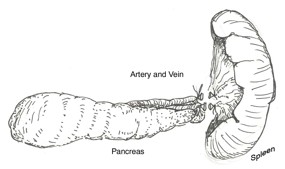What is a splenectomy?
A splenectomy is a surgical procedure to remove your child's spleen if it's diseased or not functioning.
There are several conditions for which a splenectomy may be needed:
- hereditary spherocytosis and sickle cell anemia
- chronic idiopathic thrombocytopenic purpura (ITP) with failed response to medical treatment
- Hodgkin disease or chronic leukemia in special situations
- trauma with an injury to the spleen and continued bleeding

Supplemental vaccine
If your child's spleen has been removed, ask your child's doctor about the vaccine for seven strains of pneumococcal organisms that is now available to supplement the original vaccine for 23 strains. This conjugated vaccine produces a stronger and longer lasting response than the older vaccines.
What does the spleen do?
- The spleen is an organ located in the left upper portion of the abdomen that functions as the primary filter for the blood.
- The spleen receives 5 percent of the blood pumped by the heart.
- Because the spleen is very soft, it is more susceptible to trauma than the other organs in the abdomen.
Why does my child's spleen need to be removed?
In most cases, when the spleen is removed for blood disorders (spherocytosis, elliptocytosis, idiopathic thrombocytopenic purpura (ITP), sickle cell anemia), the spleen is functioning perfectly normally and the abnormalities of the blood are producing the problem.
Anemia
The normal red cell is disk shaped and as it ages, the internal membranes break down and the cell assumes a spherical shape and is removed by the spleen about 100 days after it is created.
In conditions called spherocytosis and elliptocytosis, this change in the cell shape occurs at a much younger age of the cell leading to its premature destruction. This premature destruction results in anemia (low red cell count) and an increased risk of developing gallstones.
Gallstones
The hemoglobin in the broken-down red blood cells is then excreted as bilirubin in the bile from the liver. If the level of bilirubin in the bile is too high, it will result in gallstone production.
ITP
In idiopathic thrombocytopenic purpura (ITP), the platelets are often coated with antibody, which has been mistakenly produced by the body's immune system.
This coating of the platelets with antibody leads the spleen to see them as foreign and filter them from the blood, leading to excessive destruction.
Sickle cell anemia
Some children can develop a life-threatening crisis where blood pools in the spleen, which becomes enlarged.
How do I prepare my child for surgery?
Before your child has an elective splenectomy, a doctor should administer should vaccines against pneumococcal, Haemophilus influenza, and meningococcal organisms.
- These three families of bacteria are particularly able to produce serious infections in the blood in people without a spleen.
- These vaccines should be given at least 10 to 14 days before surgery to obtain the greatest immunologic response possible.
Current recommendations for children and adults without spleens are to have repeat immunizations every three years for children younger than 10, and every five or six years for people older than 10.
What's the surgery like?
Your child's spleen will be removed by either "open" or laparoscopic methods.
- Open surgery: The surgeon makes an incision under your child's left ribs in the upper abdomen or down the middle of the abdomen. This approach is generally required in children with significant enlargement of their spleens, in those having a partial splenectomy, or those with ITP with very low platelet counts.
- Laparoscopic surgery: This minimally invasive procedure works for children with mild enlargement in size of the spleen. It involves a small incision made under the belly button. A laparoscope is inserted through this opening, and three or four additional openings are created in the abdomen through which instruments are placed to free the spleen.
- Partial splenectomy: In some cases of spherocytosis and elliptocytosis in which the rate of red cell destruction is not too high, your child's doctor may recommend a partial splenectomy. This procedure will decrease the rate of red cell destruction and yet preserve some of the blood filtering capacity of the spleen.
What happens after surgery?
Most children stay in the hospital two to five days after the surgery. While there, your child will be monitored for signs of infection and to make sure the recovery is going well. Your child's doctor may prescribe an antibiotic for when you go home.
Are there any possible complications?
There are a few things to watch out for immediately following your child's surgery:
- bleeding
- pancreatitis (inflammation of the pancreas gland resulting from injury to the pancreas during the surgery)
There are also some longer-term complications:
- intestinal obstruction can result from scarring. These scars may block the flow of intestinal contents and produce vomiting, crampy abdominal pain, and abdominal distention. This may require another operation to correct the blockage by dividing the obstructing scar.
- A bloodstream infection (sepsis) can result from the loss of the splenic function as a blood stream filter. Your child's doctor may recommend a twice-daily dose of Penicillin G to be continued through childhood or into adulthood.
Splenectomy | Programs & Services
Departments
Surgery
Department
The Department of Pediatric Surgery provides general and specialized surgical services to those suffering from a wide range of congenital and acquired conditions.
Centers
Cancer and Blood Disorders Center
Center
The Dana-Farber/Boston Children's Cancer and Blood Disorders Center is an integrated pediatric hematology and oncology program through Dana-Farber Cancer Institute and Boston Children’s Hospital.

